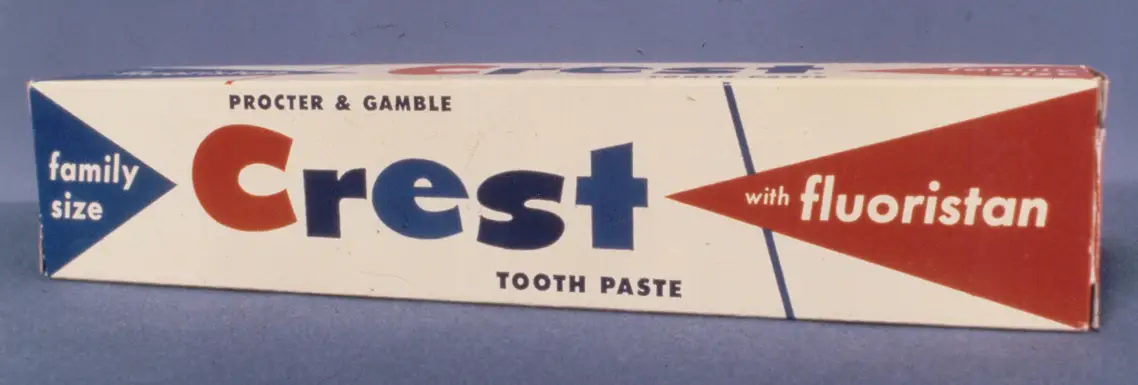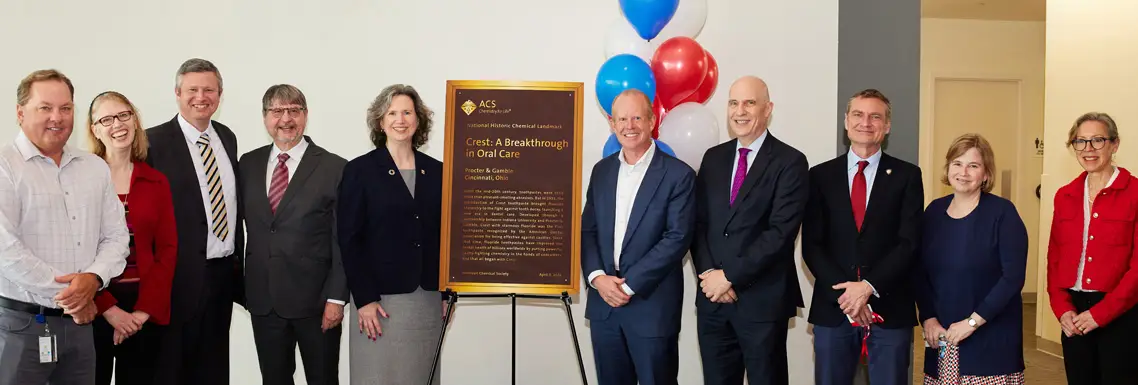
Crest Gains National Historic Chemical Landmark Designation
April 4, 2024
More than 70 years ago, the story of stannous fluoride began with a passionate professor who was part dentist, part chemist—and was inspired to help the world, despite hundreds of failed attempts. We’re proud to celebrate the American Chemical Society (ACS) designation of stannous fluoride as a Landmark Chemical, cementing the positive impact of many teams—both at P&G and our academic partners—on the field of chemistry and society.
In particular, the ACS Landmark Chemical designation recognizes innovations that have contributed to the advancement of chemical sciences, and is only granted to a few chemicals each year. Stannous fluoride joins the ranks of previous ACS designations that changed the world, like the groundbreaking discoveries of penicillin and insulin.

Throughout the 1900s, tooth decay was one of the largest health concerns in the United States. At the time, the solution to decay was extraction, leaving many people at a disadvantage for the rest of their lives. In fact, dental problems were so prevalent that the U.S. Army was forced to lift its enlistee requirement of 12 teeth during World War II, as they had trouble finding 18-year-olds who had 12 of their 32 teeth.
By the late 1940s, scientists discovered that residents in areas with naturally occurring fluoride in municipal drinking water were actually less susceptible to cavities.
Leaning into this discovery, experts at Indiana University (IU) began exploring how including fluoride in toothbrushing routines may reduce decay. The young investigator leading this project was Dr. Joseph Muhler, a trained dentist and assistant professor in the university’s chemistry department, who was searching for the best combination of ions to preserve tooth enamel.
After testing 300 fluoride compounds, he identified a type of tin fluoride, known as stannous fluoride, which made enamel more resistant to acid than any other fluoride combination.

Meanwhile, a little over 130 miles away, in Cincinnati, Ohio, head of P&G Product Research and IU alum, Verling Votaw, was also interested in the benefits of fluoride, but he struggled to include the compound in existing toothpaste formulas. After many conversations, an open innovation agreement was initiated, and P&G began to fund Muhler’s work at IU in return for shared patent proceeds.
In 1949, Muhler and a new IU professor of chemistry, William Nebergall, published dozens of studies and created and tested more than 500 combinations of fluorides and polishing agents to find a way to preserve the protective qualities fluoride offers teeth–without it all going down the sink.
And then, a mistake brought a fortunate discovery. One night, Nebergall put conventional polishing agent ingredients in an oven and mistakenly left them overnight. After the mixture was removed from the oven and cooled, the fluoride ions didn’t combine with the polishing agent (which typically caused the fluoride to go straight down the sink), but instead worked with tooth enamel to protect teeth.
That discovery enabled researchers to formulate stannous fluoride into Crest toothpastes ultimately providing broader protection against cavities, acid erosion, and other concerns like gingivitis. Crest toothpaste was the first toothpaste with stannous fluoride to receive the American Dental Association Seal of Acceptance in 1960 and in 2017, Crest became the first toothpaste to be recognized with the American Dental Association Seal of Protection against Acid Erosion.
Recipients marked the achievement at P&G’s Mason Business & Innovation Center, as well as at Indiana University, where experts gathered to celebrate the impact of the scientists’ commitment to a healthier world.

“The collaborative development of stannous fluoride in Crest toothpaste is a lasting testament to the power of bringing together institutions that share a mission of using science for the good of society,” added Gerard Baillely, PhD, senior vice president, Corporate Research & Development at P&G. “Receiving this ACS Landmark Designation is an honor that also carries the responsibility to continuing our history of science-led innovation.”
“The impact of fluoride toothpaste on healthy smiles is undeniable,” noted Mike Grieff, senior vice president, Global Oral Care R&D. “I think about the generations of people before us who were much more likely to suffer from tooth decay—like those World War II soldiers. Moments like these inspire me, and others, to pursue the next innovation that will improve oral health outcomes for more generations, everywhere.”

We’re pleased to say this isn’t the first time P&G has celebrated an ACS Landmark Designation. In fact, Tide’s Synthetic Detergent was recognized in 2006 for its unique molecular characteristics which, for the first time, enabled water to break up oils and grease and remove dirt, revolutionizing how consumers clean.
Ready to dig deeper? Read more about our expertise in Health & Hygiene.




